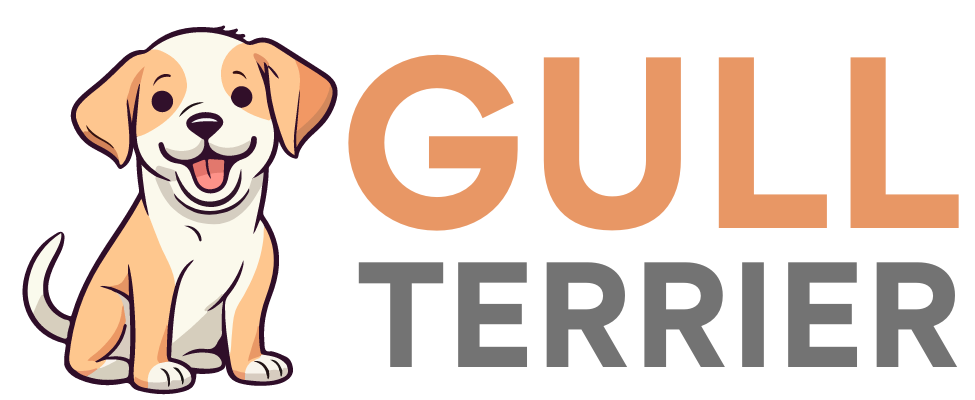Gull Terrier Dog Breed
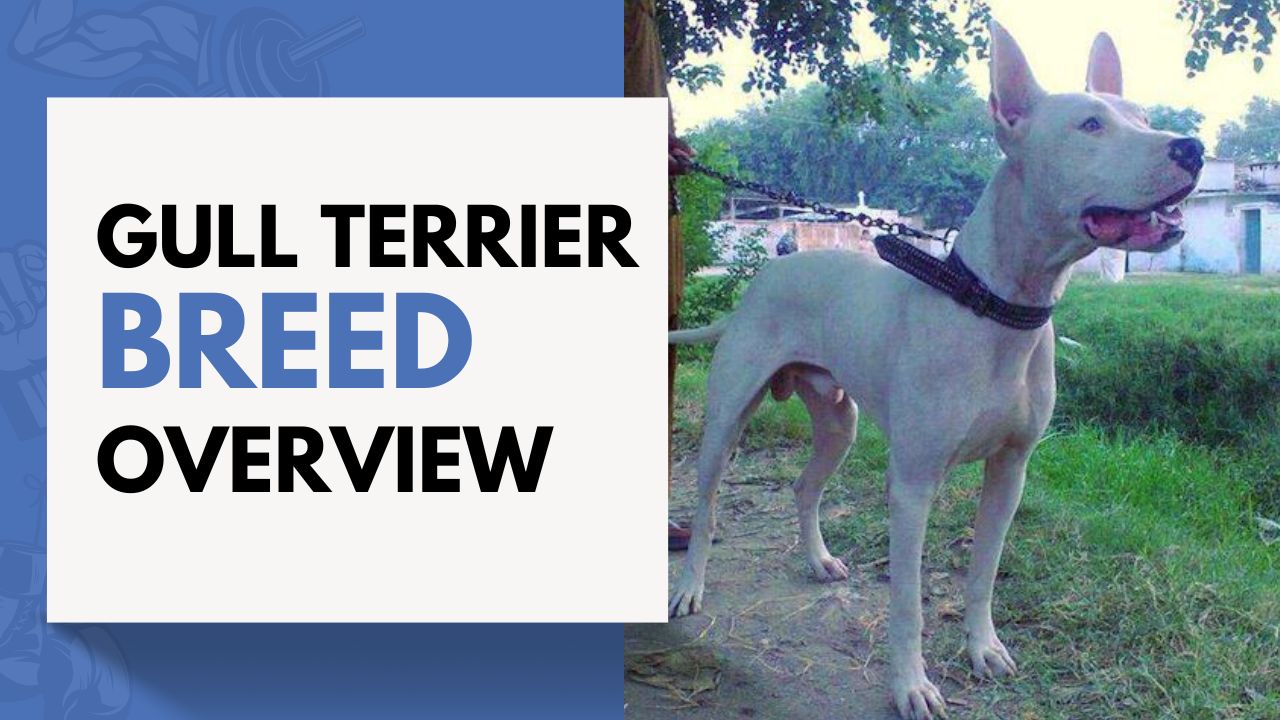
The Gull Terrier, also known in various circles as the Indian Bull Terrier and Pakistani Bull Terrier, stands out in the realm of Pakistan dog breeds for its distinctive appearance and robust stature. Recognized for its tall, broad-chested form and muscular build, this medium-sized member of the terrier breed is not only noted for a coat that is typically short, dense, and predominantly white but also for the presence of dark-colored markings that sometimes adorn their face and body. Renowned for their loyalty, Gull Terriers exhibit a strong protective instinct towards their owners and a natural wariness around strangers, characteristics that have earned them their reputation as exemplary guard dogs within the Pakistani Gull Terrier lineage.
As a breed that demands respect for its protective and, at times, aggressive nature, the Gull Terrier dog breed is best suited to experienced handlers capable of providing the structured training and socialization it requires. This article will delve into the essential facets of caring for a Gull Terrier, covering historical background, physical characteristics, temperament, and practical care tips, including exercise, grooming needs, and health considerations, to ensure they lead a balanced and fulfilling life.
History and Origin

I’m sorry, but you haven’t provided any factual keypoints for the “History and Origin” section of the article on the Gull Terrier dog breed. Without specific information or keypoints to include, I’m unable to generate content for this section. Please provide the necessary details or keypoints related to the history and origin of the Gull Terrier dog breed, and I’ll be happy to assist you further.
Physical Characteristics of Gull Terrier
The Gull Terrier dog breed, known for its medium to large size, showcases a range of physical characteristics that define its muscular and athletic build. Here are some key aspects of their appearance:
- Size and Build:
- Height: Males and females typically range from 20-26 inches (50-66 cm).
- Weight: Females weigh between 45-65 lb (20-29 kg), while males are slightly heavier at 55-65 lb (25-29 kg). Some can weigh up to 77-99 pounds (35-45 kg), indicating a variance based on specific lineage.
- Chest: Long and broad, contributing to the breed’s robust appearance.
- Coat and Color:
- Texture: The coat is short, dense, and smooth, making it easy to maintain.
- Color: Predominantly white, which may include dark-colored markings on the face and body. Variations can include white with black spots or patches, adding to their distinctive look.
- Ears and Eyes:
- Ears: They can have erect, semi-erect, or dropped ears, which are larger and more erect compared to Bull Terriers. The Gull Terriers are divided into three main species based on their ears: straight ears (Kohati Gull Terrier), erect ears, and fallen ears.
- Eyes: Piercing eyes set on a broad, flat head, giving them an alert and keen expression.
The Gull Terrier’s balanced and athletic physique not only reflects their agile capabilities but also their energetic zest for life. Their distinctive egg-shaped head, coupled with their muscular build, makes them stand out among Pakistan dog breeds. This blend of physical traits contributes to their reputation as both formidable guard dogs and loyal companions.
Temperament and Personality
Gull Terriers are renowned for their dynamic and multifaceted personalities, making them excellent companions for those who understand their needs. Here’s a closer look at their temperament and personality traits:
- Companionship and Loyalty:
- Highly trainable and thrive on companionship, requiring significant time for exercise, training, and companionship.
- They form strong attachments to their owners, disliking long periods of solitude.
- Known for their loyalty, they are considered part of the family, often becoming guardians and playmates for children.
- Socialization and Interaction:
- Good with children and can get along with other pets, especially if raised together from a young age.
- Require early socialization to distinguish between normal guest interactions and genuine threats.
- While they are protective and wary of strangers, with proper training, they can be loving, loyal, and safe companions for families.
- Protective Instincts and Guard Dog Capabilities:
- Their protective nature, agility, quickness, and alert barking make them suitable for guard dog duties.
- Highly suspicious of strangers, which complements their role as excellent guard dogs.
- Despite their tough exterior, they have a gentle and affectionate side towards family members, demonstrating unmatched loyalty and protection.
In understanding the Gull Terrier’s temperament, it’s clear that they are not just protective guardians but also affectionate family members. Their intelligence and eagerness to please make them highly trainable, yet their protective instincts require them to be socialized from an early age. This breed thrives in environments where they can form close relationships with their families, showcasing their versatility as both devoted pets and vigilant guardians.
Training and Socialization
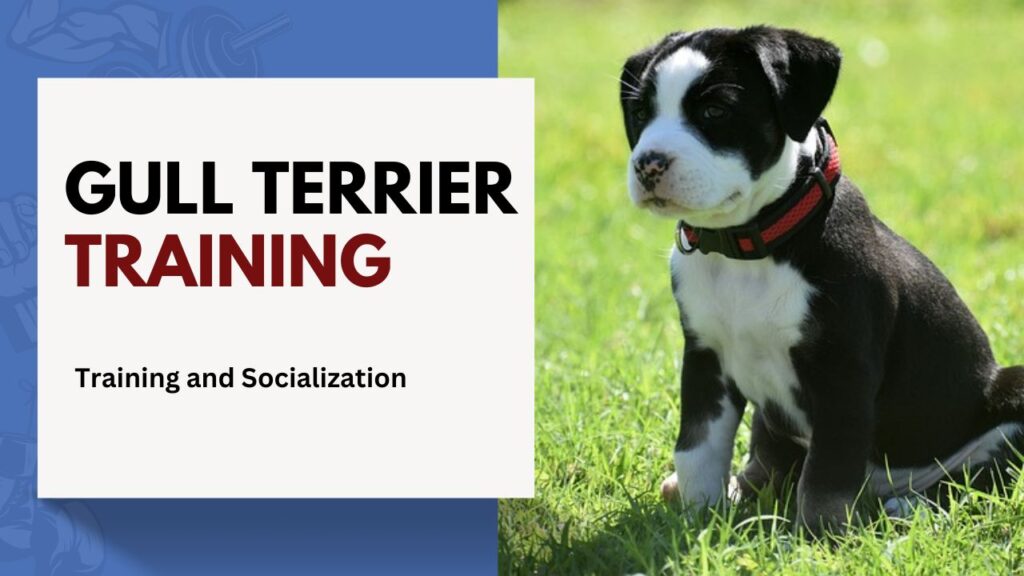
For the Gull Terrier dog breed, known for its intelligence and energy, training and socialization are not just beneficial but essential. These activities not only help in curbing their aggressive tendencies but also ensure they grow into well-mannered and sociable pets. Here’s a breakdown of the critical aspects of training and socializing a Gull Terrier:
Essential Training Tips:
- Start Early: Begin training as soon as you bring your Gull Terrier home. Early training lays a solid foundation for future behavior.
- Consistency is Key: Maintain firmness and consistency in commands and expectations. Inconsistent training can lead to confusion and undesirable behaviors.
- Positive Reinforcement: Use treats, praise, and play as rewards. Positive reinforcement encourages cooperation and strengthens the bond between you and your pet.
- Structured Training Sessions: Keep training sessions short, focused, and fun. Gull Terriers are intelligent and learn quickly but can become bored with repetition.
- Socialization: Integrate socialization with training by exposing your Gull Terrier to different environments, animals, and people. This helps them distinguish between normal interactions and genuine threats.
Socialization Strategies:
- Regular Exposure: Regularly expose your Gull Terrier to various situations, people, and other animals to build confidence and reduce anxiety.
- Monitor Interactions: Always monitor interactions with other pets and during social encounters to ensure peaceful coexistence.
- Social Activities: Engage in social activities that allow your Gull Terrier to interact with others. Activities like agility, obedience training, and nose work are excellent for socialization and mental stimulation.
Activities Gull Terriers Excel In:
Gull Terriers possess a high level of agility and intelligence, making them suitable for a variety of activities beyond basic training:
- Agility and Flyball: These fast-paced, interactive sports are perfect for Gull Terriers, providing both physical exercise and mental stimulation.
- Search-and-Rescue and Therapy Work: Their intelligence and trainable nature make Gull Terriers excellent candidates for search-and-rescue missions and therapy dog roles.
- Obedience Training and Nose Work: Participating in obedience classes and nose work/tracking can help sharpen their skills and improve their focus.
Training and socializing a Gull Terrier requires patience, consistency, and a commitment to positive reinforcement techniques. Given their intelligence and eagerness to please, Gull Terriers can excel in a variety of activities, making the training process rewarding for both the dog and the owner. Remember, the goal is to nurture a well-behaved, sociable pet who is both a loyal companion and a joy to be around.
Exercise Requirements
Gull Terriers, known for their robust energy and dynamic personalities, require a well-thought-out exercise routine to maintain their physical and mental well-being. Their need for daily physical activity is not just a preference but a necessity for their overall health. Here’s a structured approach to ensuring your Gull Terrier gets the right amount of exercise:
Daily Exercise Routine:
- Long Walks: At least one hour of walking per day is essential. These walks provide both physical exercise and mental stimulation, making them a cornerstone of the Gull Terrier’s daily routine.
- Running and Hiking: Incorporate running or hiking a few times a week. These activities cater to their high energy levels and offer a change of scenery, which is beneficial for their mental health.
- Swimming: A low-impact exercise that’s excellent for muscle strength and cardiovascular health. It’s especially beneficial in warm weather to avoid overheating.
Play and Training Activities:
- Fetch and Tug-of-War: Engaging in play such as fetch or tug-of-war provides quick bursts of energy expenditure and strengthens your bond.
- Agility Training: Offers both mental and physical stimulation. Navigating through obstacle courses keeps their mind sharp and body agile.
- Interactive Toys: Toys that stimulate their mind and require them to solve puzzles for treats can keep them occupied and mentally engaged.
Health and Safety Considerations:
- Monitor for Overexertion: Be vigilant for signs of fatigue or overheating, especially in warm weather. Gull Terriers are enthusiastic and may not know when to stop.
- Adapt to Weather Conditions: Exercise routines should be adjusted based on the weather to prevent heatstroke or discomfort.
- Tailor to Individual Needs: Consider your Gull Terrier’s age, health status, and energy levels when planning exercise routines. Puppies and senior dogs may have different requirements.
Regular exercise is not only about keeping your Gull Terrier physically fit but also about ensuring their mental health is taken care of. Insufficient exercise can lead to destructive behavior, highlighting the importance of a balanced routine that includes both high-energy play and relaxation. By recognizing the signs of sufficient exercise and monitoring for any exercise-induced health issues, you can ensure your Gull Terrier enjoys a healthy, happy, and active life.
Health and Lifespan
Gull Terriers, while generally healthy, have a predisposition to certain health issues that prospective and current owners should be aware of. These conditions can impact their quality of life and longevity, which typically ranges from 7 to 12 years. Understanding these health challenges is crucial for providing the best care for a Gull Terrier.
Common Health Issues in Gull Terriers:
- Deafness: A prevalent concern, often hereditary. The breed is particularly prone to this due to their predominantly white coat.
- Preventive Measure: The Brainstem Auditory Evoked Response (BAER) test is recommended for early detection.
- Blindness: While less common than deafness, some Gull Terriers may also suffer from blindness, adding to their special care requirements.
- Skin Allergies: Can be challenging to manage and diagnose, especially in individuals born deaf.
- Signs to Watch For: Increased scratching, red skin patches, and hair loss.
- Hereditary Nephritis: A serious kidney condition leading to failure if not addressed.
- Symptoms: Poor appetite, increased thirst and urination, lethargy.
- Other Concerns: Hip dysplasia, dental problems, and dry eye in older dogs.
Preventive Care and Management:
- Regular Veterinary Check-ups: Essential for early detection and management of health issues. Annual visits are recommended, with more frequent check-ups for older dogs or those with known health conditions.
- Balanced Diet: Plays a significant role in maintaining overall health and managing conditions like skin allergies.
- Exercise: Regular, moderate exercise helps in preventing obesity, which can exacerbate conditions such as hip dysplasia.
Incorporating these care strategies into the daily routine for a Gull Terrier can significantly contribute to a healthier, more comfortable life. Regular vet visits, awareness of the symptoms of common health issues, and preventive measures form the cornerstone of effective health management for the breed.
Grooming Needs for Gull Terrier
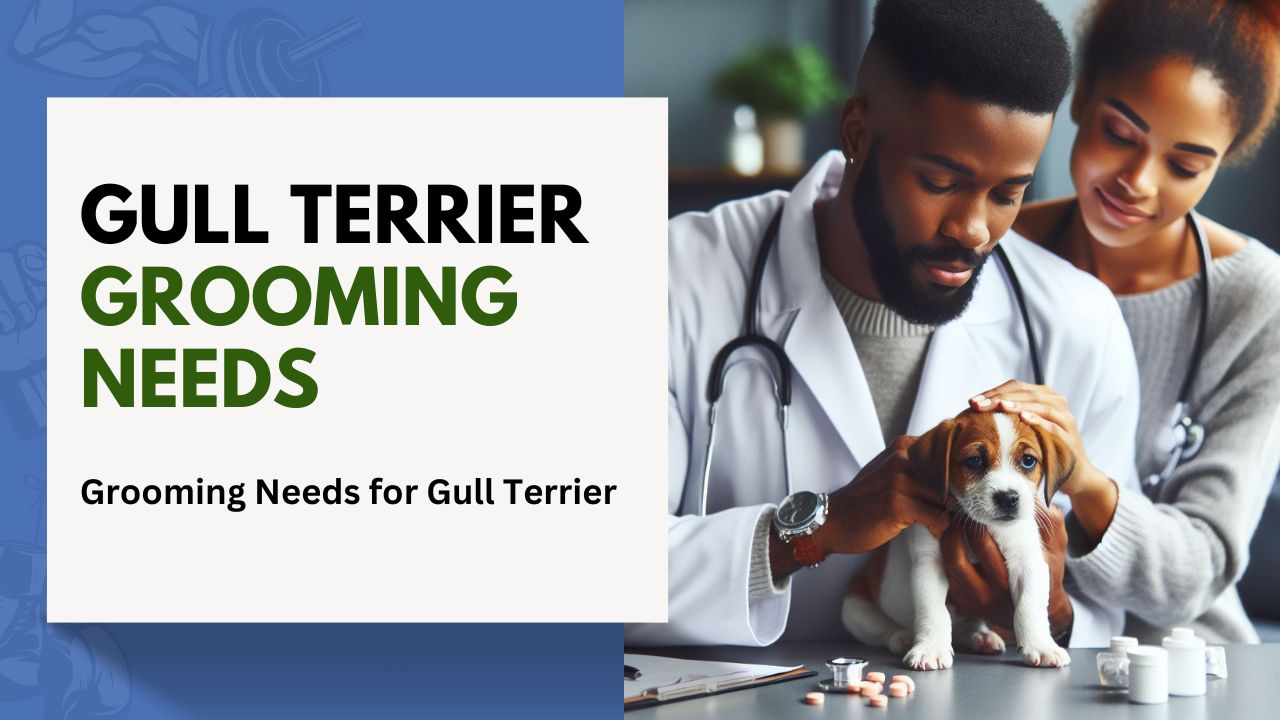
Grooming the Gull Terrier is an essential part of their care routine, ensuring their coat and skin remain healthy. While their short, flat coats might seem low maintenance, they require regular attention to stay in top condition. Here’s a structured approach to grooming your Gull Terrier:
Regular Grooming Schedule:
- Brushing: At least once a week with a soft-bristled brush to remove dead hair and minimize shedding. This also helps distribute natural oils throughout the coat, keeping it shiny and healthy.
- Bathing: Periodic baths with a mild, dog-specific shampoo. Ensure a thorough rinse and complete drying afterward to prevent any skin issues.
- Ear Cleaning: Monthly cleaning with Ear Care solutions to prevent ear infections, a common issue in dogs.
- Eye Care: Use Opti-Soothe Eye Wash during baths to remove any foreign matter and keep the eyes clear.
- Paw Care: Weekly application of Paw Balm keeps paw pads soft and prevents cracking, especially in colder months or on rough terrains.
- Coat Health: For those showing their Gull Terriers, using Silky Show Shampoo and Conditioner can add silk proteins and shine, with High Sheen Spray for that extra gloss in the show ring.
Seasonal Grooming Tips:
- Summer Care:
- Keep the coat trimmed but avoid shaving to protect from the sun while maintaining insulation.
- Increased vigilance for ticks and fleas, more prevalent in warm weather.
- Winter Care:
- Maintain a slightly longer coat for warmth, adjusting the length to provide insulation against the cold.
- Continue regular grooming routines to manage shedding and coat health.
Health and Diet for Coat Maintenance:
- Diet: Incorporate a balanced diet rich in essential nutrients like proteins, fats, vitamins, and minerals to support coat health. Omega fatty acids, in particular, can improve skin health and reduce shedding.
- Grooming Products: Use high-quality grooming tools and products designed specifically for dogs to ensure the best results and avoid any skin irritations.
Regular grooming not only keeps the Gull Terrier’s coat and skin in excellent condition but also strengthens the bond between the pet and the owner. By adhering to a consistent grooming schedule and adjusting care routines according to seasonal needs, owners can ensure their Gull Terriers not only look their best but are also happy and healthy.
Living Conditions
Gull Terriers are versatile and can thrive in various environments, provided their exercise and space needs are met. Understanding the ideal living conditions for this breed is crucial for their well-being and happiness. Here’s a breakdown of suitable environments for Gull Terriers:
- Apartment Living:
- Condition: Possible, but with stipulations.
- Requirements: Must receive ample daily exercise. This includes long walks, runs, and mental stimulation through play and training.
- Consideration: Without sufficient exercise, they may exhibit destructive behavior due to pent-up energy.
- Homes with Yards:
- Ideal Setting: A securely fenced yard is highly recommended.
- Benefits: Provides space for them to explore, play, and expend energy in a safe environment.
- Precaution: The fence should be secure to prevent escape, considering their strong chase instinct.
- Indoor and Outdoor Balance:
- Indoor: Safe indoor spaces are necessary for rest and indoor activities.
- Outdoor: Access to a garden or yard for outdoor exercises and play. Leash walking is essential to control their strong instinct to chase.
This breed’s adaptability to different living situations makes them a great companion for various households. However, the key to a happy Gull Terrier is ensuring they have enough physical and mental exercise, regardless of the living environment.
Adopting a Gull Terrier
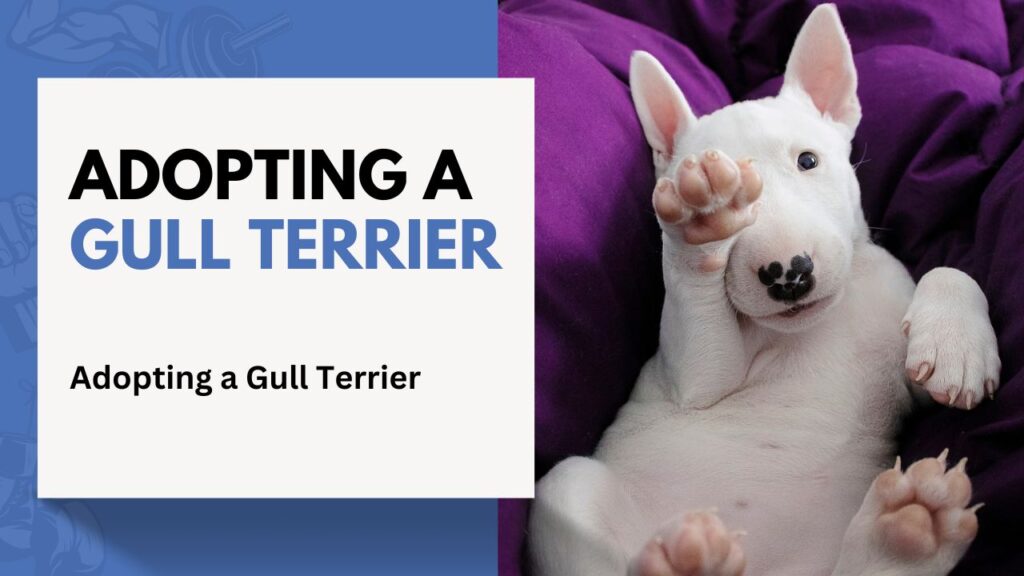
Adopting a Gull Terrier can be a rewarding experience, providing a forever home to a dog in need while enriching your life with their companionship. However, it requires careful consideration and preparation. Here’s what prospective adopters need to know:
Understanding Gull Terrier Varieties
- Types: Gull Terriers come in three main types, differentiated by size and use. This diversity means potential owners can find a Gull Terrier that best matches their lifestyle and living conditions.
- Selection: Choosing the right type is crucial. Consider your living space, exercise ability, and whether the dog’s primary role is companionship, protection, or another activity.
Financial Commitment
- Annual Care Cost: Expect to spend approximately $1,500+ per year. This includes expenses for food, routine veterinary care, preventative medications, grooming, toys, treats, and accessories. Understanding this commitment is essential for providing a Gull Terrier with a loving and stable home.
Questions for Breeders and Rescue Organizations
- Health Tests: Inquire about BAER testing for hearing and checks for kidney and heart health. These are critical for ensuring you’re adopting a healthy dog.
- Rescue Organizations: Organizations like California Paws Rescue specialize in rescuing and rehoming Bull Terriers, including Gull Terriers. They offer adoption services, volunteer opportunities, and accept donations to support their cause.
Adoption Process
- Adoptable Gull Terriers: Many Gull Terriers await adoption, from puppies to adults, each with its unique personality and needs. Videos and profiles of adoptable dogs, such as those from Schatzi’s family, provide insights into their temperament and suitability for your home.
- Adoption Steps: While specific details may vary, the general process includes an application, meeting the dog, possibly a home visit, and an adoption fee. This process ensures a good match between the dog and its new family.
Adopting a Gull Terrier offers the chance to make a significant difference in a dog’s life. By carefully considering the type of Gull Terrier that fits your lifestyle, understanding the financial commitment, asking the right questions, and following the adoption process, you can ensure a successful and fulfilling adoption experience.
Conclusion
Throughout this exploration of the Gull Terrier, we have delved into the unique aspects that define this robust and loyal breed, from their striking physical characteristics and dynamic temperament to their specific needs in training, socialization, and care. Emphasizing their marked intelligence and protective instincts, it becomes clear that the Gull Terrier is not merely a pet, but a dedicated companion and guardian to those who understand and fulfill their complex requirements. Their demanding exercise routine, specialized health considerations, and grooming needs underline the importance of informed and committed ownership to ensure these remarkable dogs lead balanced, healthy lives.
Not just a detailed guide, this narrative also serves as an advocacy for thoughtful consideration before welcoming a Gull Terrier into one’s life, underlining the profound impact of responsible pet ownership on both the breed and the broader community. As we conclude, it is the hope that this comprehensive overview not only educates but also inspires a deeper appreciation for the Gull Terrier, fostering environments where they thrive as cherished members of their human families. For those considering adoption, let this be a call to action to approach the process with the seriousness it deserves, ensuring a mutually rewarding relationship filled with loyalty, companionship, and love.
FAQs
How should you care for a Gull Terrier?
To ensure your Gull Terrier stays healthy and happy, adhere to the following care tips:
- Bathe your terrier mix approximately once a month.
- Regular brushing of their coat may be necessary, depending on its length.
- To avoid dental problems, brush their teeth daily or at least several times a week.
- Regularly trim their nails to keep them at a comfortable length.
Is it easy to maintain a terrier’s coat?
Yes, maintaining a terrier’s coat is relatively straightforward. Most terriers possess a rough, weather-proof coat that remains clean with minimal effort. However, some terriers have coats that require regular stripping to stay in optimal condition. It’s advisable to discuss coat care specifics with the breeder.
What kind of personality do terriers exhibit?
Terriers are known for their loyalty to their families, though their interest in others can vary. While some terriers may not be fond of children or the noise they make, this can differ greatly among breeds and individual dogs. Some terriers are much more tolerant and gentle.
Are terriers challenging to train?
Training terriers can be a unique challenge due to their strong-willed nature. Bred for their courage and persistence, terriers often won’t do something they’re not interested in, which can make traditional training methods less effective. Their sharp, inquisitive minds require patience and creativity in training.
